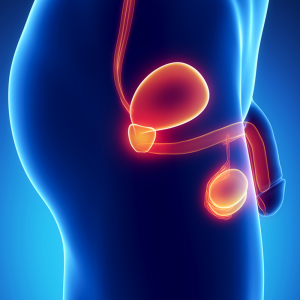Prostate cancer and physical activity
Prostate Cancer : definition and symptoms

Prostate cancer is an important cause of death in the Grand-Duchy of Luxembourg in accounting for 1.5% of all deaths. In males, it is the third cause (10.5%) of death from cancer [1]. The prostate is a gland below a man’s bladder that produces fluid for semen. This cancer, which occurs in men, is a malignant tumor that starts in the cells of the prostate. The tumor grows slowly and remains initially confined to the prostate gland. It may spread (metastasize) to distant areas of the body. The symptoms may include problems passing urine, low back pain and pain with ejaculation. Physical inactivity may be a modifiable risk factor of prostate cancer, while smoking and obesity are much more related to cancer mortality [2, 3].
The effects of physical activity on prostate cancer
Physical activity is associated with a decreased risk of prostate cancer progression or mortality [3-5]. Physical activity may decrease the side-effects of the radiation and compensate for hormonal deprivation in maintaining or increasing muscular strength, bone mineral density, cardiorespiratory fitness and sexual function, and decreasing body weight, fatigue, and psychological stress [6, 7]. After treatment, supervised exercises improve muscular strength, cardiorespiratory fitness, lower-body physical function, and mental health [8]. Physical activity may decrease the risk of cancer progression via different mechanisms such as reducing levels of insulin and inflammation, which are known to be involved in the proliferation of cancer cells [4].
What are the risks?
There are limited contraindications to the practice of physical activity. In case of skin irritation related to radiotherapy, swimming should be avoided. Physical activity should be supervised to avoid side-effects such as fracture, especially in patients treated with hormone therapy, with a diagnosis of osteoporosis or bony metastases [9]. In addition, the decrease in the patient’s physical fitness that often occurs after a cycle of therapy is a potential barrier which should be therefore addressed by decreasing / splitting the duration of activity.
Recommendations
Physical activity is strongly recommended after the diagnosis of prostate cancer. After diagnosis, physical activity recommendations state that 150 minutes of moderate physical activity or 75 minutes of vigorous physical activity should be undertaken per week [9]. Aerobic exercise should be adapted to the capacity of each patient and may include walking, cycling, swimming, tennis, and jogging [5]. Resistance and flexibility training should emphasize all of the major muscle groups. Resistance training should be 3 sets of 6 to 8 different exercises (8 to 12 repetitions at 60-80% of the maximal weight that can be lifted for each exercise) for 2 or more sessions per week [10]. In addition, pelvic floor exercises are recommended for those who undergo radical prostatectomy. High-impact exercises (up to 10 sets of 10 jumps with or without additional weight) are recommended for patients without contraindication [7].
Related groups
References
- World Health Organisation. Disease and injury country estimates – Burden of disease. 2011 [cited 2014 09/09/2014]; Available from: http://www.who.int/healthinfo/global_burden_disease/estimates_country/en/.
- Medlineplus. Prostate cancer. 2014 [cited 2014 02/10/2014]; Available from: http://www.nlm.nih.gov/medlineplus/prostatecancer.html.
- Leitzmann MF, Rohrmann S. Risk factors for the onset of prostatic cancer: age, location, and behavioral correlates. Clin Epidemiol 2012;4:1-11. Available at: http://dx.doi.org/10.2147/CLEP.S16747.
- Richman EL, Kenfield SA, Stampfer MJ, Paciorek A, Carroll PR, Chan JM. Physical activity after diagnosis and risk of prostate cancer progression: data from the cancer of the prostate strategic urologic research endeavor. Cancer Res 2011;71(11):3889-95. Available at: http://dx.doi.org/10.1158/0008-5472.CAN-10-3932.
- Kenfield SA, Stampfer MJ, Giovannucci E, Chan JM. Physical activity and survival after prostate cancer diagnosis in the health professionals follow-up study. J Clin Oncol 2011;29(6):726-32. Available at: http://dx.doi.org/10.1200/JCO.2010.31.5226.
- Gardner JR, Livingston PM, Fraser SF. Effects of exercise on treatment-related adverse effects for patients with prostate cancer receiving androgen-deprivation therapy: a systematic review. J Clin Oncol 2014;32(4):335-46. Available at: http://dx.doi.org/10.1200/JCO.2013.49.5523.
- Winters-Stone KM, Dobek JC, Bennett JA, Maddalozzo GF, Ryan CW, Beer TM. Skeletal response to resistance and impact training in prostate cancer survivors. Med Sci Sports Exerc 2014;46(8):1482-8. Available at: http://dx.doi.org/10.1249/MSS.0000000000000265.
- Galvao DA, Spry N, Denham J, et al. A multicentre year-long randomised controlled trial of exercise training targeting physical functioning in men with prostate cancer previously treated with androgen suppression and radiation from TROG 03.04 RADAR. Eur Urol 2014;65(5):856-64. Available at: http://dx.doi.org/10.1016/j.eururo.2013.09.041.
- Schmitz KH, Courneya KS, Matthews C, et al. American College of Sports Medicine roundtable on exercise guidelines for cancer survivors. Med Sci Sports Exerc 2010;42(7):1409-26. Available at: http://dx.doi.org/10.1249/MSS.0b013e3181e0c112.
Focht BC, Clinton SK, Devor ST, et al. Resistance exercise interventions during and following cancer treatment: a systematic review. J Support Oncol 2013;11(2):45-60.
Authors & expert
Authors : Alexis Lion1, Jane S. Thornton2.
Expert : Caroline Duhem3.
1 Luxembourg Institute of Health, Sports Medicine Research Laboratory, L-1460 Luxembourg, Luxembourg
2 Centre Hospitalier Universitaire Vaudois, Policlinique Médicale Universitaire, CH-1011 Lausanne, Switzerland
3 Centre Hospitalier de Luxembourg, Hématologie – Cancérologie, L-1210 Luxembourg, Luxembourg
Year of publication
2015
